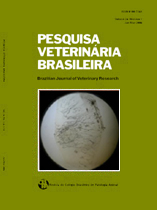 |
|
|
|
Year 2008 - Volume 28, Number 08
|

|
Avaliação radiográfica e de função de vôo após fixação de osteotomias distais de úmero em pombas (Columba livia), com modelo de fixador externo articulado, p.351-357
|
ABSTRACT.- Ferraz V.C.M., Ferrigno C.R.A., Cortopassi S.R.G., Lopes R., Isaza R. & Kim S. 2008. [Radiologic and flight function evaluation after fixation of distal humeral osteotomies in pigeons, with model of articulated external fixator.] Avaliação radiográfica e de função de vôo após fixação de osteotomias distais de úmero em pombas (Columba livia), com modelo de fixador externo articulado. Pesquisa Veterinária Brasileira 28(8):351-357. Departamento de Cirurgia, Faculdade de Medicina Veterinária e Zootecnia, Universidade de São Paulo, Cidade Universitária, Av. Prof. Dr. Orlando Marques de Paiva 87, São Paulo, SP 05508-270, Brazil. E-mail: vanessaferraz@usp.br
The treatment of distal humeral fractures in birds is very difficult, technically and for consolidation and maintenance of normal function of the wing, because theses bones are pneumatic, and its cortices very thin. The ankylosis of the humerus-radius-ulnar joint with external fixator is unviable for birds intended for rehabilitation and release. In all animals, the experimental fixator was placed over the humerus, with its articulation over the humerus-radial-ulnar joint e the extension of the fixator was placed over the ulna. The animals were divided in two groups: bilateral surgeries with ankylosis in one wing (static wing) and maintenance of the joint function in the other (dynamic wing) (Group 1), and unilateral surgery, with maintenance of the joint function (dynamic wing) (Group 2). The bonny callus was evaluated with radiographs: post-surgical, at 3, 6 and 9 weeks. The birds in Group 2 were evaluated as of their flight abilities between 11 and 15 weeks after surgery. The wing amplitude and humeral length was evaluated in all animals, after euthanasia. At 6 weeks, all the animals in Group 2, that underwent unilateral surgery, without ankylosis, and four animals in Group 1, that underwent bilateral surgeries: ankylosis of one elbow (static wing) and not of the other (dynamic wing), presented radiographic and clinical consolidation of the fractures. Two animals in Group 1 only presented consolidation of the dynamic wing at 9 weeks and of the static wing at 12 weeks. All the animals in Group 2 presented adequate flight capacity, in at least 13 weeks after surgery. There are few published papers on bird osteosynthesis, and therefore we studied the use of articulated external fixator for the stabilization of distal humeral fractures, avoiding ankylosis of the elbow joint, and, therefore keeping flight function viable, using as a model, rock pigeons (Columba lívia). The proposed method of maintenance of wing function in the dynamic wing, demonstrated being effective in maintaining the length of the bone, the amplitude of the wing as well as viability of muscles and tendons, guaranteeing flight capacity of the studied birds, being a good method for the repair of distal humeral fractures of birds, when rehabilitation and release are intended. |
| |
|
|
| |
|
 |